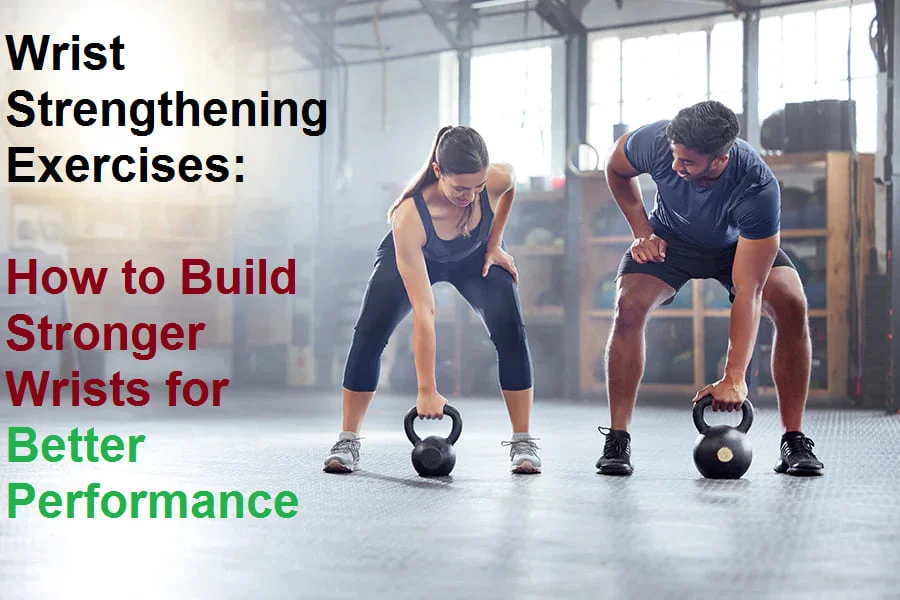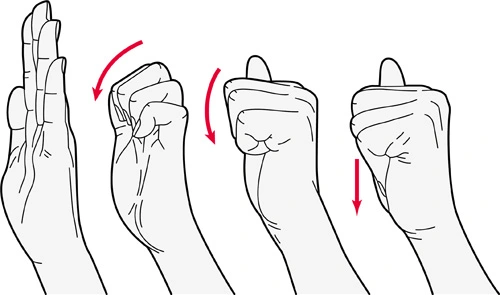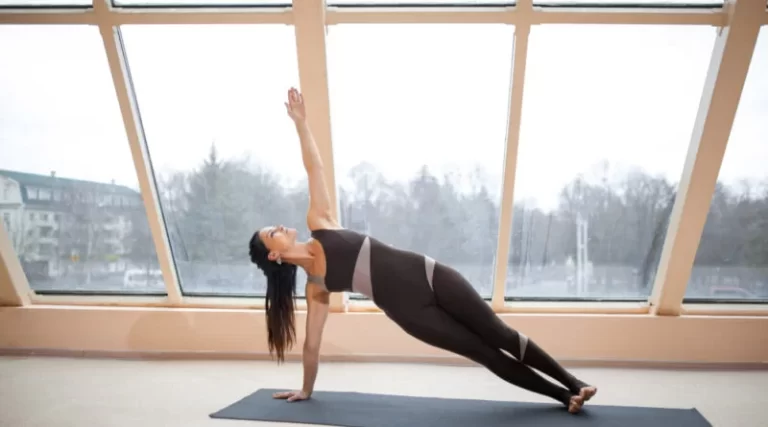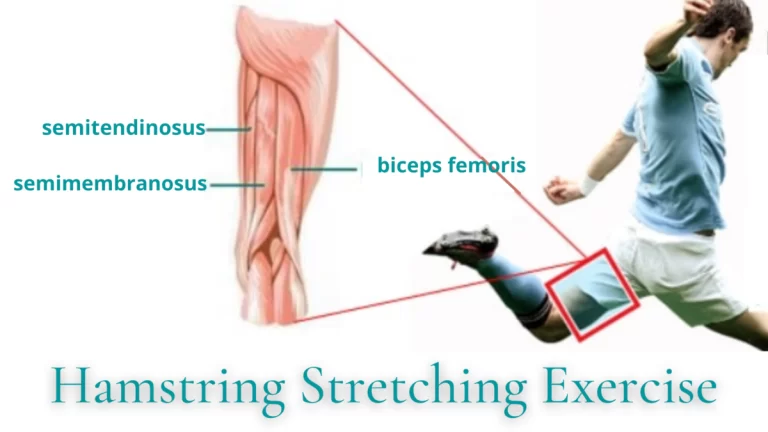Wrist Strengthening Exercises: How to Build Stronger Wrists for Better Performance
What is a Wrist Strengthening Exercise?
Wrist-strengthening exercises are a set of physical movements designed to improve the strength and flexibility of the muscles in the wrist and forearm. These exercises are beneficial for various groups of people, including athletes, musicians, office workers, and individuals recovering from wrist injuries.
Strengthening the wrists can enhance overall wrist stability, improve grip strength, and reduce the risk of injuries such as carpal tunnel syndrome and tendonitis. When performed correctly and regularly, these exercises can promote better dexterity, coordination, and overall wrist functionality, thereby facilitating daily tasks and enhancing performance in sports and other activities.
It is important to consult with a healthcare professional or a certified fitness trainer before starting any new exercise regimen, especially if you have pre-existing wrist conditions or injuries.
What are the wrist muscles?
The wrist is a complex joint that allows for a wide range of movements, such as flexion, extension, abduction, adduction, and circumduction. These movements are facilitated by a group of muscles that are responsible for controlling the motion and stability of the wrist.
There are two main groups of wrist muscles that act on the wrist: the extrinsic muscles and the intrinsic muscles.
Extrinsic Muscles:
- Flexor Muscles: These muscles are located on the anterior side of the forearm and are responsible for flexing the wrist. Flexor carpi radialis, flexor carpi ulnaris, and palmaris longus are the three primary flexor muscles.
- Extensor Muscles: These muscles are located on the posterior side of the forearm and are responsible for extending the wrist. The main extensor muscles include the extensor carpi radialis brevis, extensor carpi radialis longus, extensor carpi ulnaris, and extensor digitorum communis.
Intrinsic Muscles:
- Thenar Muscles: These muscles are located on the palm side of the hand and are responsible for controlling thumb movements. The main thenar muscles include the abductor pollicis brevis, flexor pollicis brevis, and opponens pollicis.
- Hypothenar Muscles: These muscles are located on the pinky side of the hand and are responsible for controlling pinky movements. The main hypothenar muscles include the abductor digiti minimi, flexor digiti minimi brevis, and opponens digiti minimi.
- Interosseous Muscles: These muscles are located between the metacarpal bones of the hand and are responsible for controlling finger movements. There are three sets of interosseous muscles: dorsal interossei (abduct fingers), palmar interossei (adduct fingers), and lumbricals (flex fingers at the metacarpophalangeal joints).
The wrist muscles are innervated by various nerves, including the median nerve, ulnar nerve, and radial nerve. These nerves provide the necessary signals for muscle contraction and control.
In addition to their role in wrist movements, these muscles also play a crucial role in grip strength, fine motor control, and overall hand function. They work in coordination with each other and with the muscles of the forearm and hand to perform various tasks such as writing, typing, playing musical instruments, and manipulating objects.
Wrist strengthening exercises
Finger flicks
This exercise, often known as wrist flicks, strengthens the muscles that flex and stretch the fingers. It is also an excellent approach to warm up the wrists before performing other exercises.
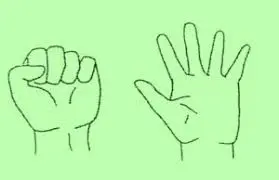
In order to perform this exercise follow the below steps
- Do the extension of your arms out in front of you and compress both hands into tight fists.
- Do the quick flicking of all 10 fingers out as wide and completely straight as possible.
- Do again this compress and flicker again for about 10-30 seconds.
Finger flicks work by engaging the muscles in your wrist and fingers, which helps to improve grip strength and dexterity. This exercise can be beneficial for anyone who uses their hands frequently, such as athletes, musicians, or people who work with their hands. Additionally, finger flicks can be done anywhere and require no equipment, making them a convenient option for strengthening your wrists and hands.
Finger slides
Finger slides help in improving range of motion and are another best way to warm up the hands and wrists.
In order to perform this exercise follow the below steps
- Keep one arm outward in front and also do the flexion of the wrist so that your palm is facing forward.
- Do not make a fist, gradually slide the fingertips towards the bottom of your fingers and then down to the base of your palm.
- Make sure you reverse the movement step by step, making sure to articulate the fingers uncurling.
- Do it again for 5-10 times on each side.
To make this exercise more challenging, you can try sliding your fingers up and down the wall with just one hand at a time or using a resistance band or weight to add resistance to the movement.
Dumbbell wrist extension
If you do not have a dumbbell, you can do wrist extension exercises with an ordinary household object or a resistance band.
In order to perform this exercise follow the below steps
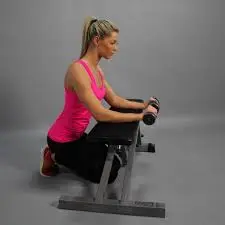
- Place your forearm on a table, bench, or chair, with your wrist and hand off the border and your palm facing down, while gripping a light dumbbell in your hand.
- Raise the dumbbell up while keeping your forearm stationary by curling your hand up and back towards your arm till your wrist is fully extended.
- Hold for a second before gradually dropping the dumbbell back to the initiate position.
- Do again for 2-3 sets of 8-12 repetitions on each side.
Dumbbell wrist extension is a great exercise for improving grip strength, wrist stability, and overall forearm strength. It is especially beneficial for athletes who rely on grip strength, such as rock climbers, weightlifters, and martial artists. In order to prevent damage, start with lesser weights and slowly raise the amount of effort required.
Dumbbell wrist flexion
Wrist flexion exercises can also be practiced with resistance bands or any different weights.
In order to perform Dumbbell wrist flexion follow the below steps

- Keep a light dumbbell in your hand, then place the back of your forearm on a table, bench, or chair so that your wrist and hand are off its edge and your palm is directed toward the ceiling.
- Maintain your arm stable, and curl the dumbbell up in the direction of your wrist as far as you can.
- Hold it before gradually dropping back to the initiate position.
- Do again for 2-3 sets of 8-12 repetitions on each side.
To increase the intensity of this exercise, you can use heavier weights or perform more sets and repetitions. You can also perform this exercise with both hands at the same time.
Dumbbell wrist flexion is a great exercise for improving grip strength, wrist flexibility, and overall forearm strength. It is especially beneficial for athletes who rely on grip strength, such as tennis players, golfers, and baseball players. In order to prevent damage, start with lesser weights and slowly raise the amount of effort required.
Dumbbell wrist pronation to supination
It is critical for this exercise that the action originates below the elbow rather than from the shoulder. You can practice without weights first to perfect your technique.
In order to perform this exercise follow the below steps
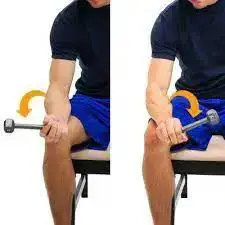
- Place your forearm on a table, bench, or chair, with your wrist and hand off the border and your palm facing down, while gripping a light dumbbell in your hand.
- Maintain your upper body still, and gradually rotate the hand until your palm faces the ceiling.
- Do again for 2-3 sets of 8-12 repetitions on each side.
It is especially beneficial for athletes who rely on rotational movements, such as tennis players, golfers, and baseball players. In order to prevent damage, start with lesser weights and slowly raise the amount of effort required.
Dumbbell wrist radial to ulnar deviation
In order to perform this exercise, only move as far as you can while keeping your forearm on the support. You should probably start with no weights.
In order to perform this exercise follow the below steps

- Take a light dumbbell in your hand, and put the side of your forearm on a table, bench, or chair in a neutral position, so that your palm is facing towards the center of your body.
- Maintaining your arm flat, raise your hand upward and backward towards your arm so that it leans in the direction of the ceiling.
- Hold it and then reverse the movement, moving past the initiate position and moving your hand towards the surface of the floor.
- Do again for 2-3 sets of 8-12 repetitions on each side.
Finger push-ups
This type of exercise is excellent for developing hand and wrist strength. If you find it too difficult, move your hands more in front of your shoulders to reduce the strain on your wrists.
In order to perform this exercise follow the below steps

- Begin on all fours in a tabletop position knees should be under hips and wrists should be under shoulders.
- Push up through your fingers to elevate your palms off the surface of the floor.
- Come back downward ensuring both hands land flat at the same time.
- Do again for 2-3 sets of 5-8 repetitions.
Wrist curls
This strengthening exercise can be performed with either a clenched fist or 1- to 5-pound weights. You can perform both arms simultaneously or one arm at a time. Your physical strength determines it. As a weight, a little food can or a bottle of water can be utilized.
In order to perform this exercise follow the below steps
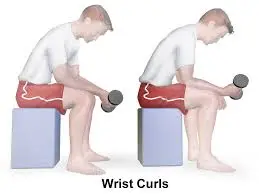
- Place your arm over your legs and sit comfortably.
- Grasp a weight with your palms down and your wrist above your knee.
- In a calm and controlled action, raise your hand as high as you can and then lower it as far as possible.
- When you can easily complete two or three sets, you might want to raise the weight you’re using.
- Wrist curls can also be done with your arm in position in the air.
- Perform a set of 10, then do it again.
- Do the exercise again, but with your palms facing upward.
- Once you can do 2 or 3 sets with ease, you may want to raise the weight you are using.
- You can also do wrist curls while your arm is in the air.
Resistance band exercise 1
Resistance bands are inexpensive and adaptable fitness tools. They are present in various types of strengths. Begin with a gentle resistance band if you are recovering from an injury. If you are practicing for a sport, however, go with a heavier band.
This exercise engages your wrist flexors and extensors.
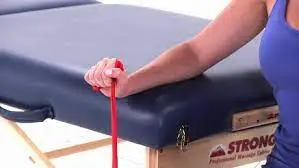
In order to perform this exercise follow the below steps
- Start with sitting comfortably, place your arm on a table and your palm should be facing down and your hand should hanging over the table corner.
- Place one end of the resistance band beneath your foot and the other end in your hand. To produce tension, you may need to tie it around your hand.
- Pull up and extend your wrist to as much as you can against the resistance. Maintain a smooth and controlled motion.
- Gradually return back down to the initiate position.
- Do it again 10 times.
- Perform with your other hand.
Perform the same exercise, but this time begin with your palms facing upward.
Resistance band exercise 2
In order to perform this exercise follow the below steps
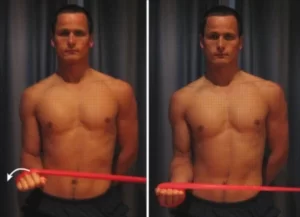
- Start with sitting comfortably with your arms near to your body, bent at right angles.
- Keep a band tight with both hands, palms should be facing downward
- Gradually turn your wrists so that your palms are facing upward and stretch the band.
- Maintain your arms and elbows in place.
- Do it again for a few times.
Home exercises
Use both hands for one-handed tasks.
For the majority of individuals, the wrist of the dominant hand is significantly more powerful than the wrist of the non-dominant hand. If you make an attempt to start utilizing your non-dominant hand for daily tasks, you may be amazed at how difficult they are to complete. Continue with it as time passes, your weaker wrist will strengthen, and doing daily tasks will become smoother. Here’s a small list of things you can start doing with your off-hand.
- Brushing your teeth
- Writing
- Using a computer mouse/touchpad
- Eating
- Stirring
Try compressing a stress ball or palm workout gadget.
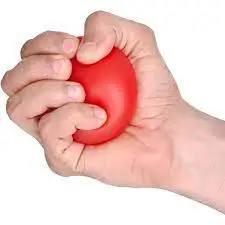
Squeezing a stress ball or palm workout gadget may be beneficial. You may have noticed these hand-held training equipment in gyms, high-stress environments (such as home offices), and other places. Though they come in a variety of shapes and sizes, the essential concept remains unchanged for all of them. Squeeze the device hard yet steadily, then relax your grasp and repeat. This is the end of it.
These are ideal for when you just need one hand. For example, It is simple to get a wrist exercise in while talking on the phone or reading a book.
Try a golf wrist exercise.
Are you planning on hitting the links in the near future? Get your golf clubs ready for this exercise, which will help you strengthen your wrists across their complete range of motion. You can also use any long, rigid object that is sufficiently lightweight to be handled with one hand (for example, a broom).
Grab a golf club by the end of the handle while standing with your arms at your sides. Gradually raise your wrist in the direction of the sky, then lower it again. Continue until you feel a satisfying “burn” in your forearm.
Start with a light club and work your way up to your biggest one for an added challenge.
Try doing wrist circles.
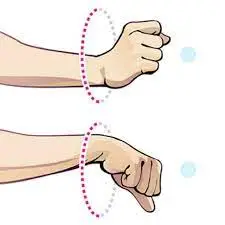
These low-resistance exercises are ideal for quick breaks at work or when you are unable to perform more sophisticated workouts (for example, when flying). Wrist circles are sometimes used in physical therapy, but do not let that prohibit you if you are totally healthy, as they may be a terrific relaxer if you’re experiencing “all wound up.”
Stand or sit with your palms down in front of you. Wrists should be moved in a gentle circular manner to the left, then back to the right. To add an extra degree of mobility to the workout, clasp and unclench your fists as you do this. Once you’ve worked out any kinks, flip your palms over and begin again.
Do the rice bucket exercise. our unusual exercise has little in common with the others on our list, but it is easy to set up and practice, and it is quite effective for improving wrist and forearm strength.
In actual fact, some baseball clubs offer it to their players as a means to strengthen their wrists. All you will need for this exercise is a container that is large and deep enough to hold both hands properly without touching, as well as sufficient rice for digging your hands in.
Curl your wrists with your palms facing you.
Perform reverse wrist curls with your palms facing a distance from you.
Why wrist strength is important?
Wrist strength is important for several reasons. Here are some detailed explanations:
- Injury Prevention: Strong wrists can help prevent injuries, especially in activities that involve repetitive or forceful movements of the hands and wrists. This includes sports like tennis, golf, weightlifting, and martial arts. By strengthening the muscles and tendons around the wrist joint, you can reduce the risk of sprains, strains, and overuse injuries.
- Improved Performance: Many activities require wrist strength to perform at an optimal level. For example, in sports like basketball or volleyball, strong wrists are essential for effective shooting, passing, and serving. In weightlifting or gymnastics, wrist strength is crucial for maintaining proper form and control during exercises such as snatches, cleans, handstands, or push-ups.
- Enhanced Grip Strength: The wrists play a significant role in grip strength. Whether it’s holding a racket, gripping a barbell, or carrying heavy objects, strong wrists provide a solid foundation for a powerful grip. This can improve performance in various sports and activities, as well as everyday tasks that require gripping and lifting.
- Functional Movements: Wrist strength is essential for performing functional movements in daily life. Simple tasks like opening jars, using tools, typing on a keyboard, or carrying groceries rely on wrist strength and stability. Having strong wrists allows you to perform these activities with ease and reduces the risk of strain or discomfort.
- Rehabilitation and Recovery: Strengthening the wrists is often part of rehabilitation programs for individuals recovering from wrist injuries or surgeries. By gradually increasing the strength and flexibility of the wrist joint, rehabilitation exercises can aid in the healing process and restore functionality.
- Overall Upper Body Strength: The wrists act as a link between the hands and the rest of the upper body. Having weak wrists can limit the amount of weight you can lift or the intensity of exercises you can perform. By improving wrist strength, you can enhance your overall upper body strength and maximize your potential in various exercises and sports.
Developing wrist strength exercises such as wrist curls, wrist extensions, grip exercises (e.g., using hand grippers), and yoga poses like downward dog or plank can be beneficial. However, it is crucial to start with proper form, gradually increase intensity, and avoid overexertion to prevent injury.
FAQ
What are some wrist-strengthening exercises?
Some wrist strengthening exercises include wrist curls, wrist extensions, grip exercises (such as using hand grippers), and yoga poses like downward dog or plank.
How should I start with wrist-strengthening exercises?
It is important to start with proper form and gradually increase the intensity of the exercises. Begin with lighter weights or resistance bands and gradually progress to heavier weights or higher resistance levels.
How often should I do wrist-strengthening exercises?
The frequency of wrist-strengthening exercises can vary depending on individual goals and fitness levels. It is generally recommended to perform these exercises 2-3 times a week, allowing for rest and recovery in between sessions.
Can wrist-strengthening exercises cause injury?
Like any exercise, improper form or overexertion can increase the risk of injury. It is important to start with lighter weights or resistance levels, maintain proper form throughout the exercises, and listen to your body’s limits. If you have feelings of pain or discomfort, you need to get medical treatment.
Can wrist strengthening exercises help with wrist pain or discomfort?
In some cases, wrist strengthening exercises can help alleviate wrist pain or discomfort by improving the stability and strength of the wrist joint. However, it is important to consult a healthcare professional for an accurate diagnosis and personalized treatment plan if you are experiencing persistent or severe wrist pain.
Reference
- Petty, A. (2020, August 27). The Body Part You Really Should Be Working: Your Wrists. Greatist. https://greatist.com/health/how-to-strengthen-wrists#exercises
- Cerqua, P. (2023, August 17). 4 Ways to Strengthen Your Wrists – wikiHow. wikiHow. https://www.wikihow.com/Strengthen-Your-Wrists
- 10 Of The Best Wrist Strengthening Exercises | PureGym. (n.d.). PureGym. https://www.puregym.com/blog/best-wrist-strengthening-exercises/
- Hecht, M. (2019, July 8). 11 Ways to Strengthen Your Wrists. Healthline. https://www.healthline.com/health/how-to-strengthen-wrists#resistance-1
- Image: Finger Push Ups. (n.d.). skimble.com. https://www.skimble.com/exercises/13404-finger-push-ups-how-to-do-exercise
- Image: Prajapati, N. (2022, April 21). Exercises for wrist pain: Mobilization, Stretching – Strengthening Exercise. Samarpan Physiotherapy Clinic. https://samarpanphysioclinic.com/exercises-for-wrist-pain/#google_vignette
- Image: S. (n.d.). Dumbbell Wrist Extension Over Bench. Fit Drills Website. https://www.fitdrills.com/exercise/dumbbell-wrist-extension-over-bench/
- Image: Exercises for the fingers, hands, and wrists. (n.d.). Versus Arthritis. https://versusarthritis.org/about-arthritis/exercising-with-arthritis/exercises-for-healthy-joints/exercises-for-the-fingers-hands-and-wrists/

